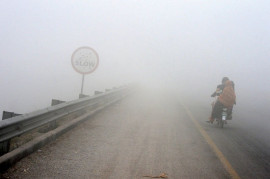
Beejo di Kabr is a historical marvel located inside Durrani Graveyard near Wazir Bagh, just outside the walled city. The mausoleum reportedly marks the grave of Bibi Jan, the beloved mistress of King Taimur Shah Durrani who ruled the Durrani Empire from 1772 till his death in 1793.
In Peshawar, there are several historical graveyards, each earmarked for an influential family. The burial ground on Wazir Bagh Road was where the Durranis were laid to rest with the remains of their glory and relics of honour. The grounds used to boast of monuments, parks and mosques but now most of it has been lost to time and lack of preservation.

The now dilapidated mausoleum is associated with a string of folklore and legends, all embellished and handed down from each generation of locals to the next.
The monument, which was supposedly built to honour Bibi Jan, has two doors which have been permanently sealed. The stairs stand towards one of the windows on the north side. Right in the middle of the mausoleum stands an unmarked mud house which is said to be Bibi Jan’s grave.
But according to Ahmad Hasan Dani, renowned archaeologist who has authored several books on the city: “Nothing can be said precisely about the person buried inside.” Dani made this observation in his book Peshawar.
Most of what is known about the king’s consort has been spun from snippets and footnotes by historians.
“Bibi Jan lived near Wazir Bagh more than two hundred years ago…she was much loved by King Taimur Shah Durrani,” writes Ahmad Nawaz Khan in his booklet Peshawar, the unwritten history.
Nawaz Khan goes on to note Beejo di Kabr or Beejo ka Muqbara, the impressive domed mausoleum on Wazir Bagh Road, belongs to Bibi Jan.
According to legend, Bibi Jan and King Taimur were in love, something the queen strongly despised. It is said, out of hatred, the queen referred to Bibi Jan as Beejo, hence the reference Beejo di Kabr.
“It was out of hatred; Bibi Jan was poisoned by Taimur’s queen,” writes Nawaz Khan. After Bibi Jan’s demise, King Taimur buried her in his ancestral burial grounds, added the writer.
Nawaz Khan maintains King Taimur was the one who had the mausoleum constructed over her grave out of love but cannot explain why it was never completed. “The reason it was not decorated or even plastered by the king could be either the death of the king or something which will never be known,” he writes.
The Durrani Graveyard also holds the desecrated grave of Sardar Muhammad Ayub Khan, the victor of the Battle of Maiwand. A number of relics were stolen from Ayub Khan’s grave in 2010.
Locals move about freely in the family graveyard and Bibi’s burial site. Upon asking, they narrate the love story of Bibi and the king much like a favourite bedtime tale – easy to read and taking on each person’s tenor.
Technically, the archaeology department is responsible for the preservation of this historical site. But on the surface it seems all but abandoned.
“We have never seen any officials of the department,” said Noor Muhammad, a local elder. Muhammad shares Bibi Jan’s mausoleum was in a better state in the days unmarked by militancy and graced by foreign tourists. However, he argues this could be achieved again, Beejo di Kabr could be turned into a tourist attraction if efforts are made to preserve and renovate the site.
Published in The Express Tribune, November 12th,2013.
COMMENTS (5)
Comments are moderated and generally will be posted if they are on-topic and not abusive.
For more information, please see our Comments FAQ
















1734778885-0/Untitled-(10)1734778885-0-270x192.webp)






Why is it so difficult to do an audit of all the historical buildings and sites and action a plan to preserve it. There is no will. politicians and officials only do things where they can put a big chunk in their pockets.
@goggi saheb , I hope you are joking .
A sad truth about both sides of the subcontinent we have common rich history and culture . Both the sides are not able to keep it from crumbling down. If we had not separated 7 decades back, would it still be in this dilapidated state OR would we collectively have done something about it - I often wonder.